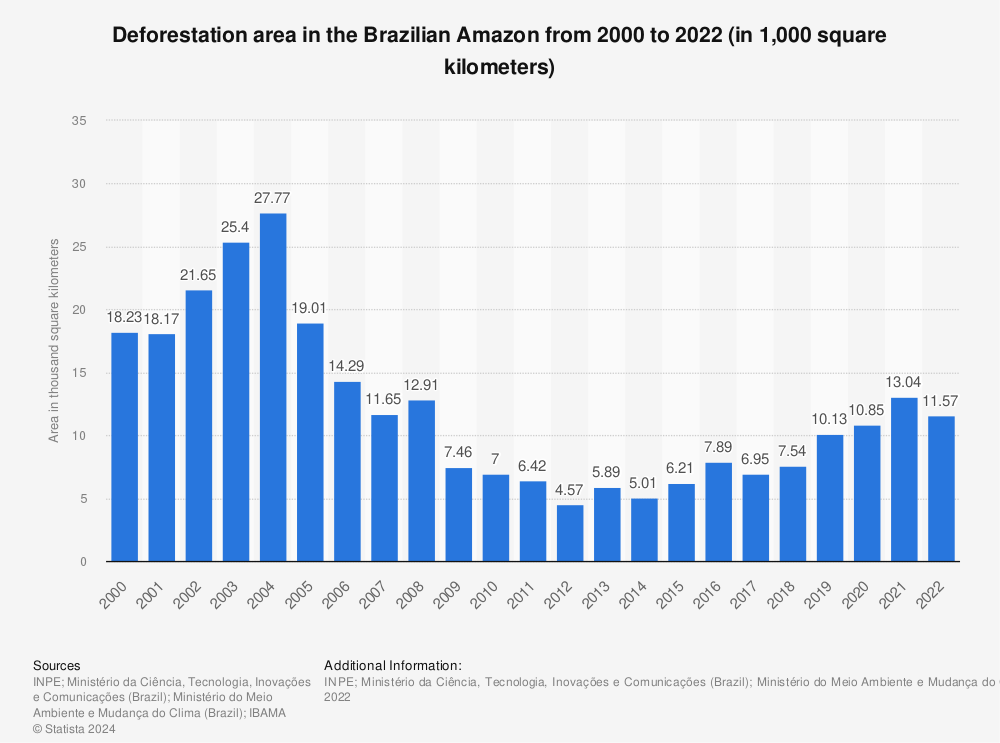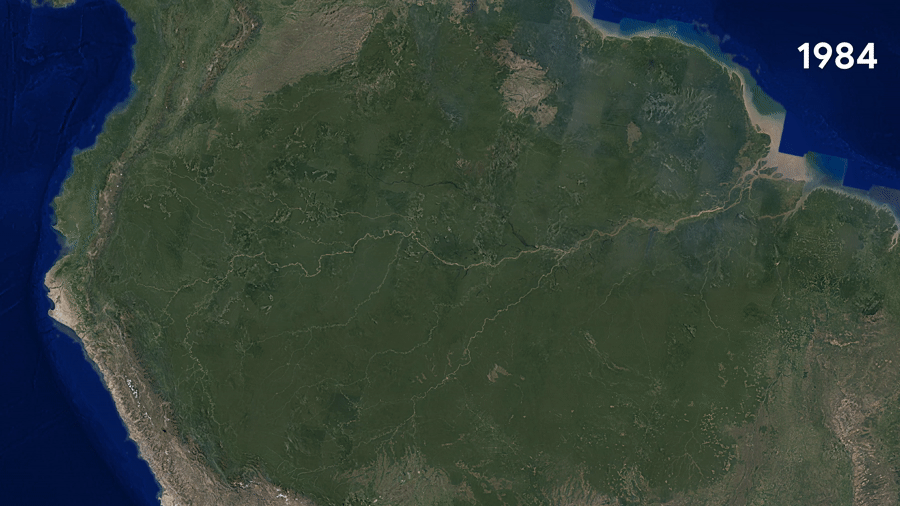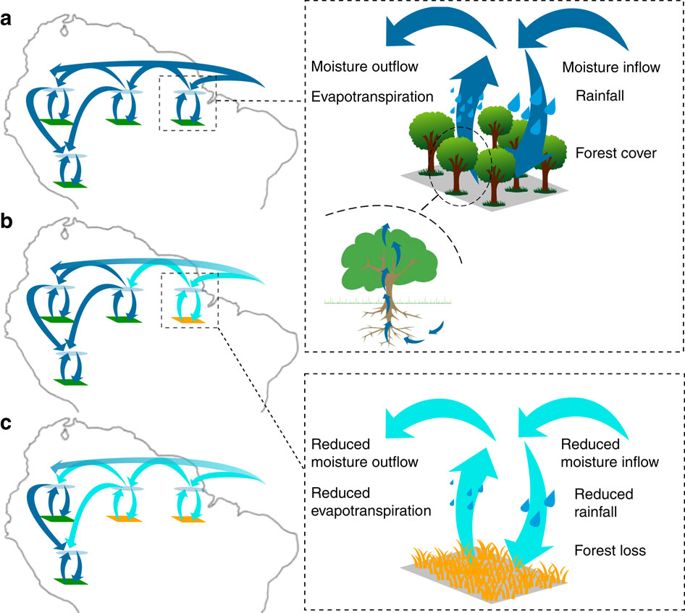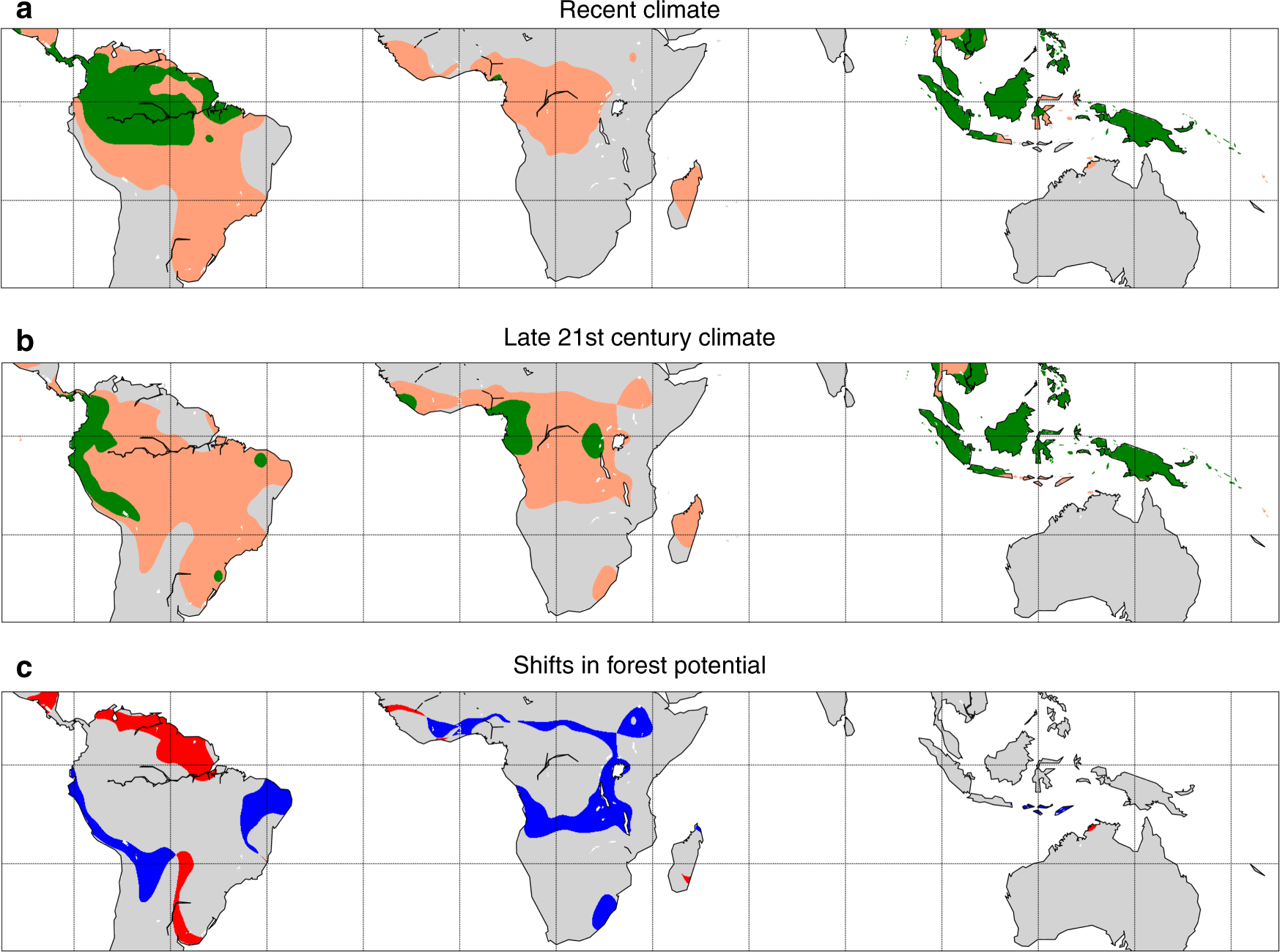The Amazon contains half of the Earth’s remaining rainforest, but is being degraded by deforestation and climate change. It’s possible it could even hit a “tipping point” beyond which a wide-scale ecosystem collapse becomes inevitable. In this explainer we take a look at how this could happen, what the impact would be, and whether it can still be stopped.
The Amazon rainforest is one of the most biodiverse places on Earth, including around half of the planet’s remaining rainforests and ~10% of known global species despite only covering ~1% of the Earth’s surface. It’s also home to millions of people from Indigenous peoples and local communities, with Indigenous territories covering ~35% of the Amazon, together with incredibly diverse and complex ecosystems creating high biocultural diversity.

Despite this, the Amazon has suffered significant deforestation and fragmentation over the last few centuries and in particular the last few decades, with clearance for cattle ranching, soy plantations, logging, and mining reducing the rainforest’s extent by ~17% since 1970 and degrading a further ~17%. Having fallen to a historical low in Brazil (which covers ~60% of the Amazon) in 2012, deforestation gradually increased again from 2015 and accelerated in 2019 under newly elected President Bolsonaro:

Data from Statista
This long-term deforestation is pushing many rare species to the brink of survival, and their loss would help drive what is becoming potentially the sixth mass extinction of life in Earth’s history. Deforestation is also pressuring the Indigenous peoples and local communities who depend on the forest, who have been displaced or marginalised by resource extraction as well as suffering health impacts from pollution, threatening the cultural diversity of the Amazon as well as its biodiversity.

Credit: Google Earth Timelapse (Google, Landsat, Copernicus)
Rainforest in the balance
Over the last few years there’s been a lot of discussion of Amazon dieback as a “climate tipping point“, with some claiming that passing the tipping point, and the extra warming that would lead to, are already inevitable.
Researchers are worried that beyond a certain level of deforestation or warming that the rainforest could start to retreat on its own, even if deforestation or warming stopped. This is referred to as the “Amazon dieback” tipping point, with the term tipping point describing when change in a system like the Amazon becomes self-sustaining independent of its original driver, carrying on until it reaches a totally new state.
The Amazon rainforest is partly self-sustaining, making around a third to a half of its own rainfall by recycling moisture from the Atlantic inland and expanding the range the forest can grow in. The forest also cools itself, with moisture recycling acting like a giant ‘air-conditioner‘. But if enough trees are lost in key areas from either drought or deforestation this recycling is reduced, leading to other areas upwind drying out and becoming vulnerable to wildfires. Rainforest trees are also vulnerable to fires, which are made more frequent by warming-induced droughts.
This means that for large parts of the Amazon there are actually two or more stable ecosystem states for a given amount of yearly rainfall: wet rainforests or drier grassy savannah (known in Brazil as cerrado). The former is capable of sustaining itself through moisture recycling, but if tree cover drops low enough the forest becomes too dry and dies back to savannah.
There is evidence that this is at least partially the case in the Amazon, especially in the drier south and east and central areas upwind of them. The worry then is that at some point sufficient forest would be lost in critical rain-producing regions to dry out and warm up forests upwind enough for them to either die back to drier savannah or patchy degraded forests instead, and for this process to carry on cascading further upwind:

The work of Brazilian climate scientist Carlos Nobre has been particularly important in understanding Amazon dieback. In 2016 Nobre estimated with colleagues that the tipping point would occur at ~40% deforestation or ~3-4°C of global warming. This matches other modelling studies which found the risk of dieback grows above 2oC and becomes significant in the 3 to 5oC range, and would take around 100-200 years to fully play out.
However, in 2018 Nobre and ecologist Thomas Lovejoy estimated that deforestation-induced tipping could be as low as 20-25% due to interactions with warming-induced droughts not fully captured by their models. Amazon deforestation reached 17% in 2018 and so is uncomfortably close to that lower end 20%, which is why the upsurge in Brazilian deforestation under President Bolsonaro has triggered calls for action.
More recent models suggest the forest may even be more resilient to climate change than first feared due to high adaptability (allowing it to survive past natural dry periods), and the Scientific Panel for the Amazon found a basin-wide threshold was too uncertain to identify. Key feedbacks like nutrient limitations or wildfires are not yet well represented in many models though and rainfall projections vary widely, and so model projections remain uncertain. These estimates are also only for climate forcing, with the combination of deforestation and warming making widespread dieback more likely.
As the figures above are expert estimates and there is some uncertainty around model projections, these tipping point estimates are still very uncertain and likely heavily depend on the level of warming reached and the exact pattern of deforestation. However, 20-25% deforestation acts as a provisional precautionary threshold that is wise to stay within, even if the actual tipping point threshold turns out to be higher.

When might the Amazon hit this risk zone? One 2019 report claimed it could be reached as soon as 2021/2022, but based this on an exponential increase in deforestation in Brazil, reaching ~35,000 square kilometres in 2019 and ~70000 square kilometres this year. However, actual figures were ~10,130 and ~11,090 square kilometres in 2019 and 2020 respectively, which if maintained would take around 15 years to reach the 20% figure.
However, campaigners are now worried that proposed new laws in Brazil annulling many Indigenous land titles would open up the Amazon to intensified deforestation. Around 35% of the Amazon is covered by official Indigenous territories, with Indigenous Peoples recognised by the Intergovernmental Panel on Biodiversity IPBES as globally effective stewards of biodiversity, and so even a partial loss of these territories could push deforestation in to the dieback risk zone.
Activists have recently petitioned the International Criminal Court to hold President Bolsonaro criminally responsible for the destruction of the Amazon and its global climate impacts. The Congress of Indigenous Organisations of the Amazon River Basin (Coica) have also called for Indigenous-led protected areas to cover 80% of the Amazon Basin and receive a greater share of global conservation funding and support.
A new scientific body known as the Science Panel for the Amazon (an ‘IPCC for the Amazon‘, which released its first report at COP26 in Glasgow) declared recently that “a code red for the Amazon” should be announced, calling for an immediate moratorium on deforestation in tipping-prone regions with zero Amazonian deforestation or degradation by 2030, along with secure land rights for Indigenous peoples, ecological restoration, and better trans-border governance.
Negative feedback
Severe Amazon degradation and eventual dieback would act as a “positive” amplifying feedback on climate change, resulting in more CO₂ in the atmosphere along with much more regional warming.
The Amazon biome stores between 150-200 billion tonnes of carbon (a.k.a. gigatonnes of carbon, GtC) in its plants and soil, and as a major natural “carbon sink” removed around 5-10% of yearly human CO₂ emissions from the Earth’s atmosphere over the last few decades as a result of CO2 fertilisation (peaking at around 700 million tonnes of carbon a year in the 1990s).
However, degradation from deforestation and fragmentation means that the Amazon likely now emits more CO₂ than it absorbs, particularly in the heavily degraded south-east. This sink-to-source transition is not a tipping point in itself and could still be reversed, but still means the Amazon is now amplifying rather than reducing global warming.

If wide-scale dieback were to be triggered then far more CO₂ release could be locked in over the coming decades. The total Amazon carbon store is estimated to be 150-200 GtC (with ~70GtC in plants), with total dieback to savannah estimated to release 53-70 GtC and raise atmospheric CO₂ by 25-33 ppm, around 5 to 7 years worth of current human emissions. Along with biogeophysical feedbacks this CO₂ rise would be enough to cause an extra 0.1-0.2oC of global warming over the next century, along with extra regional warming of 1-2oC as the forest’s self-cooling ability is reduced.
This assumes total rainforest dieback, in contrast to the models that project worst-case Amazon rainforest biomass shrinkage of 24–40% (releasing 15-25 GtC) by 2100, or a more spatially patchy tipping point (with dieback being highly localised). However, a 2020 study showed that the area of “bistable” forest (that can exist either as rainforest or savannah, and therefore can experience rainfall feedback-induced dieback) would expand from the current ~40% to almost the entire Amazon biome under a severe-warming RCP8.5 scenario.

This means that at current levels of global warming deforestation-induced dieback would be limited to the south and east of the Amazon (and so cause less additional global warming). However, at the 3-4oC of global warming estimated to be capable of tipping an intact Amazon, dieback could affect the majority of the rainforest and reach the higher warming feedback estimate. The combination of deforestation and warming also makes widespread dieback more likely, which conversely means ecological restoration of degraded forests could reduce the possibility of widespread dieback.
Amazonian myths
Much like the fanciful myths of colonial settlers in South America, the Amazon continues to attract a number of modern-day myths (such as that the Amazon is a pristine, uninhabited wilderness, despite the presence of many indigenous peoples and pre-colonial civilisations) that confuse our understanding of its role in the Earth system.
Unlike some reporting, the Amazon dieback tipping point is from a rainforest to a savannah state (mostly grass with ~20% tree cover) and not to a full desert state. Models also show dieback would take decades, making the tipping point more of a long-term locking-in of inevitable dieback rather than happening “almost overnight”. And contrary to claims that Amazon would quickly “burn down” at 3oC global warming and cause as much as 1.5oC of extra warming, as discussed above dieback would gradually release a lot but not vast amounts of carbon.
A further subtlety is that it matters where deforestation takes place. While cutting down an area that produces rain for forests upwind could cause trigger dieback upwind, some areas are less important for upwind forests and so their loss would have fewer knock-on effects. Early results suggest the south is more important for rain-making, and the northern and western Amazon more resilient against forest loss elsewhere. This means that the 20% deforestation could be worse concentrated in some areas than in others, and dieback potentially a patchy process, complicating risk assessment.
Another common worry is that ~20% of the atmosphere’s oxygen might be at risk if the rainforest were to collapse, with the Amazon sometimes described as the “lungs of the Earth”. While the Amazon does make a lot of oxygen it is mostly used up again for respiration, with the oxygen currently in the atmosphere the legacy of millions of years of ocean phytoplankton forming a long-term carbon sink. Thankfully, that means the oxygen we breathe can’t suddenly decline.
There have also been many stories over the years incorrectly implying the Amazon was likely on the verge of or even past the dieback tipping point already. One article implied that a 2020 study showed ~40% of the Amazon was on the verge of dieback, when in fact the study simply showed that this was the current extent of “bistable” forest that could be either rainforest or savannah. Reports of the Amazon carbon sink declining or transitioning to a net source are also sometimes imprecisely discussed as tipping points rather than as a shift in feedbacks (although a sink-to-source transition warns that tipping could happen soon, and dieback can’t be ruled out).
Summary
Despite not yet reaching a dieback tipping point though, deforestation and climate change have likely already driven the Amazon to become an overall carbon source rather than a carbon sink. This makes the Amazon now an amplifier rather than a brake on human-caused climate change.
The possibility of wide-scale dieback in the Amazon – triggered by a reduction in the moisture recycling that generates much of the Amazon’s own rainfall – grows after reaching ~20% deforestation and/or 2oC of global warming, and becomes more likely by 40% deforestation and/or 4oC of warming. This dieback would occur over multiple decades rather than years, and the long-term global warming caused by a total dieback would be around 0.1-0.2oC.
Together with the ongoing sink-to-source transition, triggering wide-scale Amazon dieback would make keeping to the Paris climate target of well under 2oC much harder, and the more ambitious 1.5oC target nigh on impossible. Given that deforestation has already reached ~17% in the Amazon and global warming has reached around ~1.2oC, reducing global CO₂ emissions and halting rainforest degradation are paramount both for ensuring what remains of the Amazon can survive and to keep global warming as close to 1.5oC as possible.
Even though Amazon dieback is uncertain, a tipping point likely not yet reached, and it would not cause a sudden climate catastrophe, this does not reduce the importance of the Amazon rainforest for the Earth. It still harbours huge ecological and cultural diversity and forms a critical part of the Earth system’s carbon and water cycles. That full dieback has not yet been reached and that degradation can still be halted and partially reversed makes this a critical window in which the Amazon’s fate has not yet been determined.
Further listening on Amazon deforestation and tipping points:
~
This post was written by Dr. David A. McKay, a Climate-Biosphere Scientist working as a Freelance Research Consultant and Science Communicator at Georesilience Analytics. He’s currently working with Future Earth on the Earth Commission project, providing Earth system analysis and modelling support on setting safe and just limits for nutrients (focusing on ocean impacts) and for the climate (focusing on climate tipping points). This post and site are not externally funded, and the post was proofread and edited by Dr. Rachael Avery.
Featured Image: After a rainforest wildfire in Porquinhos Indigenous Territory in Brazil’s Maranhão state, in the south-eastern Amazon. Credit: Felipe Werneck/Ibama By Ibama from Brasil – Terra Indígena Porquinhos, Maranhão, CC BY 2.0, https://commons.wikimedia.org/w/index.php?curid=74323984
Update log: 12/11/21 with links and extra details from the newly released Science Panel for the Amazon report.

